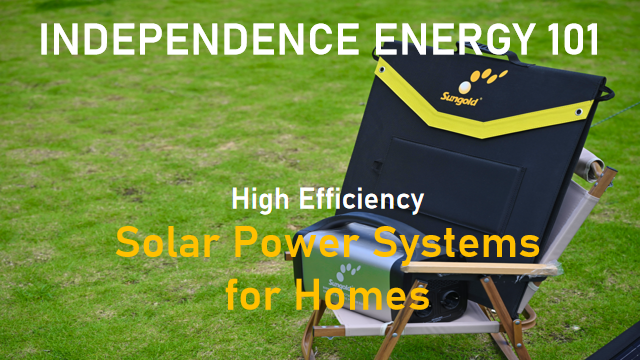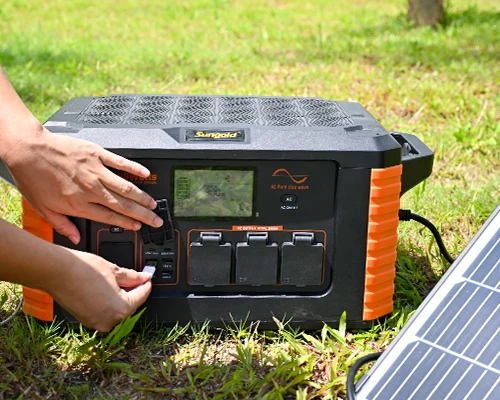When talking about home solar energy systems, do you first think of rooftop solar or ground-mounted solar farms, which often come with expensive purchase and installation costs? With portable energy storage becoming a big hit in the solar market, the application of portable solar panels in solar power systems for homes is becoming more and more common.
In this article, we’ll cover information about the components of solar power systems for homes, how to build them, and the pros and cons of using portable solar panels in solar power systems for homes.
Basic Components of Solar Power Systems for Homes
Solar power systems for homes are made up of several key components, the centerpiece of which are solar panels. These panels are responsible for converting sunlight into electricity to supply the home with power. In addition, inverters, battery storage systems, power meters, and the cables that connect these components are also integral parts of the system. When designing a home solar energy system, it is vital to ensure that these components work together efficiently.
There are many types of solar panels, mainly divided into two types: crystalline silicon panels and thin film panels. Crystalline silicon panels are further divided into monocrystalline solar panels and poly-crystalline silicon panels, which differ in the purity and shape of the crystals. Monocrystalline silicon panels are more efficient, but also more costly. Polycrystalline panels are less efficient, but also less costly. Thin-film panels are made of amorphous silicon or other materials; they have the advantage of being lightweight, flexible, and inexpensive, but they are also the least efficient.
The function of an inverter is to convert the DC power generated by the solar panels into AC power so that it can be matched with the home power system. The types of inverters are centralized inverters, series inverters, and micro-inverters. A centralized inverter is where all the solar panels are connected to one large inverter, which is simple and cheap but is susceptible to localized shading or faults. Series inverters are where each group of solar panels is connected to a small inverter, which improves efficiency but adds cost and complexity. Micro-inverters are where each solar panel is connected to a micro-inverter, this maximizes efficiency but is also the most expensive and complex.
Battery energy storage systems serve to store excess electrical energy for use at night or on cloudy days. Battery storage systems include lead-acid batteries, nickel-cadmium batteries, nickel-metal hydride batteries, lithium-ion batteries, and sodium-sulfur batteries. Different types of batteries have different performances, life, and price. Generally speaking, lithium-ion batteries have the best performance, but also the highest price. Lead-acid batteries have poorer performance but are also less expensive.
The role of power meters is to measure the power generated and consumed by the solar system and its interaction with the grid. The types of power meters are unidirectional meters and bidirectional meters. Unidirectional meters can only measure the electricity delivered by the solar system to the grid, and this is suitable for homes that rely entirely on solar energy. Bidirectional meters can measure the power delivered by the solar system to and from the grid, and this approach is suitable for homes that are partially dependent on solar energy. Bi-directional meters allow for net metering, which is the calculation of electricity bills based on the net value of the electricity delivered to and taken from the grid by the solar system, which can result in savings on electricity bills.
The role of cables is to connect the components of the solar system to ensure the transmission of power. The types of cables are DC cables and AC cables. DC cables are used to connect the solar panels to the inverter and AC cables are used to connect the inverter to the power meter. Cables are selected by considering factors such as voltage, current, length, and impedance to minimize power loss.
Steps to Build a Home Solar System
ENERGY ASSESSMENT: Before selecting and installing solar power systems for homes, you first need to assess the home’s energy needs. This step determines how large the system needs to be to meet the home’s electricity needs. There are two methods of energy assessment: self-assessment and professional assessment. A self-assessment is an estimate of monthly electricity consumption and peak load based on the home’s electrical equipment, habits, and bills. A professional assessment is conducted by a professional energy consultant or solar company, who will use specialized instruments and software to measure and analyze the home’s electricity usage, as well as provide the best solar system solution.
Selecting Solar Panels: Based on the results of an energy assessment, select solar panels that are appropriate for the needs of your off-grid solar. Consider the efficacy, durability, and installation requirements of the solar panel. Efficacy is the power output of a solar panel per square meter, measured in watts. Durability is the solar panel’s lifespan and resistance to aging, usually measured in years. Installation requirements refer to the weight, size, and shape of the solar panel, as well as the requirements for the mounting position and angle. In general, the principles for selecting solar panels are high efficiency, durability, and suitability.
Inverters and Energy Storage Systems: Installation of inverters to convert DC power generated by solar panels to AC power, as well as configuring an energy storage system to use the stored power at night or on cloudy days. There are two methods of selecting an inverter and energy storage system: stand-alone selection and off-grid solar kits selection. Stand-alone selection involves choosing the appropriate inverter and storage system on your own, based on the output characteristics of the solar panels and the household’s electricity needs. The kit option is to purchase the matching inverter and storage system provided by the solar company. This approach ensures the compatibility and stability of the inverter and storage system but may sacrifice some performance and cost.
INSTALLATION AND CONNECTION: Hire a professional installation service to ensure the solar system is properly and securely installed on the roof or ground. Properly connect all components to ensure that power flows seamlessly to your home’s electrical system. There are two types of installation and connection steps: self-installation and professional installation. Do-it-yourself installation involves installing and connecting the solar system yourself, following the solar system’s instructions and videos. This method saves money on installation costs, but requires some skill and time. Professional installation is done by a solar company or a certified installer who will take care of the transportation, installation, and commissioning of the solar system. This method ensures a quality and safe installation but requires a certain installation fee.
Pros and Cons of Portable Solar Panels
Portable solar panels are solar panels that can be carried and used anywhere, and they are often coupled with portable energy storage systems to form a portable solar system. Portable solar panels are more flexible than traditional rooftop installations and can be moved and repositioned as needed. Portable solar panels can also be used as a backup power source for solar power systems for homes, providing reliable electrical support during power outages or emergencies. However, portable solar panels also have some disadvantages, such as power limitations and dependence on the weather.
Advantage:
- Flexibility: Portable solar panels are more flexible than traditional rooftop installations, allowing them to be moved and repositioned often as needed. This allows you to avoid being affected by buildings, trees, or other obstructions, as well as optimize the reception of the solar panels based on the position and angle of the sun. Portable solar panels also provide the flexibility to increase or decrease the number and arrangement of solar panels depending on the home’s electricity needs.
- Emergency Backup Power: Portable solar panels can be used as a backup power source for the home, providing reliable power support during power outages or emergencies. For example, in situations such as natural disasters, wars, or social unrest, portable solar panels can provide households with electricity for basic lighting, communications, and medical care. Portable solar panels can also provide families with convenient power services on occasions such as outdoor activities, traveling, or camping.
Disadvantage:
- Power limitations: Portable solar panels are typically low-powered, making it difficult to meet the full power needs of large-scale household solar power systems for homes. The output power of portable solar panels is limited by the area, efficiency, and number of solar panels, which usually can only provide a few hundred watts or a few kilowatts of electricity. Such power can only meet part of a household’s electricity needs, such as lighting, refrigerators, and televisions, but not the household’s high-power electricity needs, such as air conditioners, water heaters, and washing machines.
- Weather Dependent: Under cloudy or cloudy weather, the portable solar panel performance decreases and cannot fully utilize solar energy resources. The output power of portable solar panels is affected by the intensity and duration of sunlight. When the weather is cloudy or changeable, the intensity and duration of sunlight will be reduced, leading to a decrease in the power production of solar panels. This makes it necessary to rely on an energy storage system to supplement the power, but the storage system also has a limited capacity and lifespan, and cannot guarantee a stable supply of power for a long period.
Future Development Trends
As technology continues to advance, home solar systems will become smarter and more efficient. It is expected that future solar technologies will further improve the conversion efficiency of solar panels and reduce costs, making home solar systems more attractive. At the same time, portable solar panels may improve in design and power to meet the needs of different households.
Some possible trends are:
- Flexible Solar Panels: Flexible solar panels are solar panels that can be bent and folded, and they use several new materials such as organic solar cells, dye-sensitized solar cells, and chalcogenide solar cells. The advantages of flexible solar panels are that they are lightweight, portable, and aesthetically pleasing, and can be adapted to fit a variety of shapes and surfaces, such as windows, tents, and clothing. The disadvantages of flexible solar panels are lower efficiency, shorter lifespan, and less stability.
- TRANSPARENT SOLAR PANELS: Transparent solar panels are solar panels that can transmit visible light, they utilize special structures or materials such as nanowires, quantum dots, organic molecules, etc. to absorb non-visible portions of the light such as ultraviolet and infrared light. The advantage of transparent solar panels is that they can be integrated with the glass windows or curtain walls of a building without affecting the lighting and aesthetics while generating electricity. The disadvantages of transparent solar panels are that they are less efficient, more costly, and more technically difficult.
- High-Power Solar Panels: High-power solar panels are solar panels that can produce higher output power than typical solar panels, and they utilize some advanced technologies such as multi-junction solar cells, concentrated solar cells, and space solar cells. The advantages of high-power solar panels are that they can dramatically increase the efficiency of solar energy utilization, reduce the footprint of solar panels, and meet large-scale power demands. The disadvantages of high-power solar panels are higher costs, greater technical difficulty, and higher maintenance requirements.
Understanding and applying this knowledge in Independence Energy 101 will provide more sustainable and efficient energy solutions for families.
More Article from Independence Energy 101:
Independence Energy 101: Activating Life with Off-Grid Solar Kits















